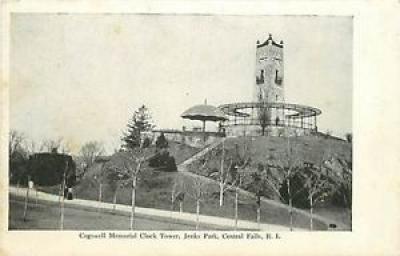Jenks Park & Cogswell Tower History
Built in 1890 by Albert Humes, Jenks Park was a gift to the city from Alvin Jenks, a descendent of early industrialist Captain Stephen Jenks.Its picturesque walkways take visitors away from the modern world (and the City Hall that abuts it),leading them past iron umbrellas and up toward Cogswell Tower, for over a century the defining symbol of the City of Central Falls.
A bequest by Caroline Cogswell led to the construction in 1904 of the eponymously-named tower, whose four clock faces provide unparalleled views of the city in all four directions. Standing almost seventy feet tall, the tower is supported by a brick barrel vault that rests atop historic Dexter’s Ledge.
Dexter’s Ledge was originally known as Quinsniket, a rocky ledge with a commanding view of the valley below and a key role in King Philip’s War. Due to a series of land disputes and broken peace treaties between the local natives and early English settlers, King Philip’s War had erupted in 1675. It was at the base of Quinsniket that Nanunteenoo, better known as Canonchet, Chief Sachem of the Narragansett, held his council fires in preparation for one of the most notorious attacks in the war.
On March 26, 1676, Nanunteeno’s scouts atop Quinsniket spied colonial troops and allied Native Americans approaching. Leading this band of 83 men was Captain Michael Pierce, a former ensign under Miles Standish. The sixty-year-old Pierce and his forces soon were in full pursuit of what appeared to be a small party of wounded warriors. Unfortunately for Pierce and his forces, these “wounded” warriors were but decoys, and the colonialists found themselves ambushed by Nanunteenoo’s forces on the eastern side of the Blackstone River. More unfortunately still for Pierce and his men, their efforts to escape the ambush by crossing the river to its western side led to an even bigger ambush by hundreds of Narragansett warriors. By the end of “Pierce’s Fight,” as it came to be known, Pierce and all but ten of him men were dead, the survivors taken away to be tortured, with but one survivor to tell the tale.
Placed on the U.S. National Register of Historic Places in September, 1979, the park and tower are a perfect destination not only for their silent witness to an epic era in the region’s history but for those looking for a picnic or meditative stroll amidst an otherwise busy day. And with the recent relighting of Cogswell Tower, the park is an ever better host to festivals celebrating the ethic diversity that unites us.

